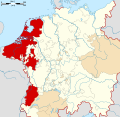Lordship of Mechelen
This article does not cite any sources. (November 2012) |
Lordship of Mechelen | |||||||||
|---|---|---|---|---|---|---|---|---|---|
| Early Middle Ages–1795 | |||||||||
 Lordship in 1350 | |||||||||
| Status |
| ||||||||
| Capital | Mechelen | ||||||||
| Government | Feudal Lordship | ||||||||
| Lord of Mechelen | |||||||||
| Historical era | Middle Ages, Early Modern Period | ||||||||
• Established | Early Middle Ages | ||||||||
• Disestablished | 1795 | ||||||||
| |||||||||
| Today part of | Antwerp Province | ||||||||
The Lordship of Mechelen was until 1795 a small independent Lordship in the Low Countries, consisting of the city of Mechelen and some surrounding villages.
In the early Middle Ages, it was part of the Prince-Bishopric of Liège, which was confirmed in 910. In practice, the area was ruled by the local family, against the will of the Prince-Bishops of Liège. The Duchy of Brabant tried to annex the Lordship, but as a reaction, Liège gave the area in 1333 to the County of Flanders. The Flemish also didn't gain complete and permanent control.
Mechelen was therefore later considered one of the Seventeen Provinces and then as a province of the Southern Netherlands. The Dukes of Burgundy and later the Habsburg Emperors and Kings were personally Lords of Mechelen and for a while turned the city more or less into the capital of the Netherlands. They established here the highest jurisdictional court of the Seventeen Provinces, called the Great Council of Mechelen. Governess Margaret of Austria also held her Court at Mechelen. Later, the capital moved primarily to Brussels.
In 1795 the Lordship was abolished by the French revolutionaries and it became part of the French département of the Deux-Nèthes. Today it is part of the Belgian province of Antwerp.
Areas of the Lordship of Mechelen[]
- the walled city of Mechelen
- the hamlets Nekkerspoel, Nieuwland, Pennepoel, Battel, Geerdegem and others
- the villages of Hever, Muizen, Hombeek, Leest and Heffen
- In a separate enclave, Heist-op-den-Berg and some hamlets like Gestel.
- Lordship of Mechelen
- Seventeen Provinces
- History of Mechelen
- 1795 disestablishments
- Geographic history of Belgium
